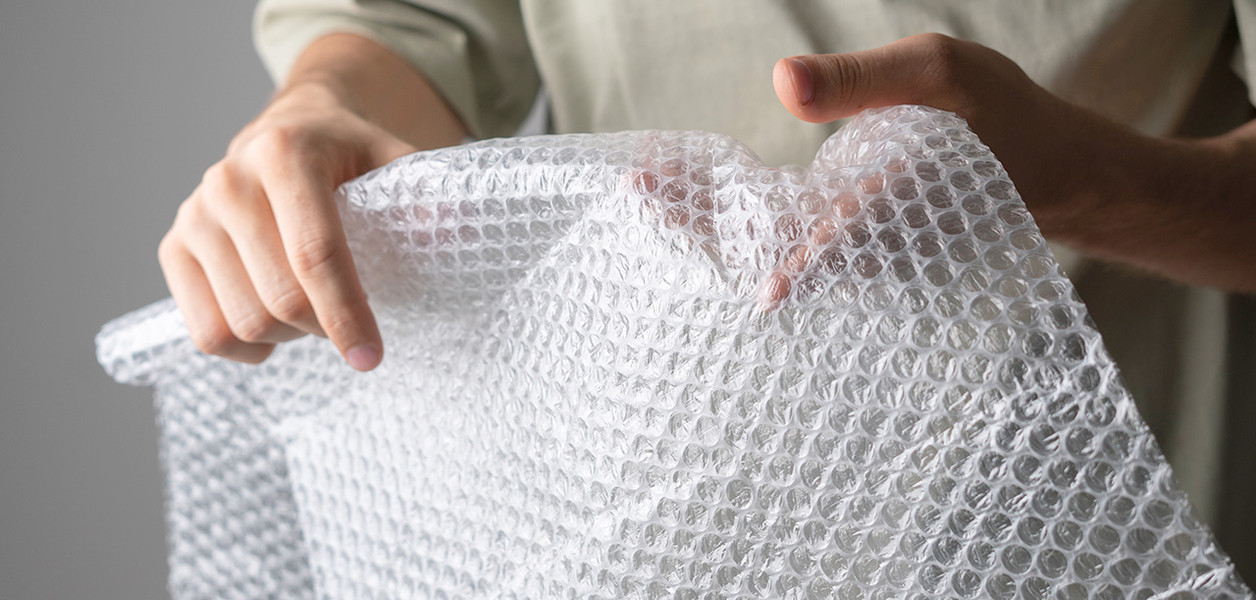Let’s face it - among our best associations with bubble wraps is de-stressing and popping the bubbles one at a time. And interestingly, bubble wraps bring this de-stressing characteristic with them even in packaging.
They’re the go-to cushioning when packing and shipping fragile items, taking off the stress of breaking in transit. But what exactly are they? How are they made? When should you use them? What’s the best way to use packaging bubble wrap? And what’s the best place to buy bubble wrap wholesale?
Well, this article is going to answer all those questions and more! So, let’s get started.
Bubble Wrap - The Surprising Origins
It may come as a surprise, but Bubble Wrap is the name of a trademarked brand that makes cushioning products.
Invented in 1957 by Alfred Fielding and Marc Chavannes in New Jersey, the bubble wrap resulted from sealing two shower curtains together to be sold as wallpaper. Only in 1961 was its protective usage in packaging discovered.
Initially, bubble wraps were used for the packaging of IBM computers. Today, they are used most by the food industry.
So, when is it ideal to use packaging bubble wrap?
Bubble Wrap - Its Many Uses
While you can use bubble wrap to protect and cushion any item for packaging, using it for fragile, valuable, and odd-shaped items is most recommended. These can include:
- Crockery
- Glassware
- Wall art
- Mirrors
- TVs
- Computers
- Decorative Items
- Vases/Lamps
- Electronics
- Paintings/Frames
Then again, certain items require unique properties in bubble wraps. Let’s check out the types of bubble wraps.
Bubble Wrap - Its Types
The air bubbles in bubble wraps range between ¼” to 1”, 0.4” being the most commonly used. Smaller bubbles are good for protecting items from scratches, whereas larger bubbles are ideal to protect against impact. A bubble wrap with larger bubbles is generally preferred in most cases, as it protects against both scratches and impact.
Among the types of bubble wraps you can choose from, besides their bubble size standards, are:
- Kraft paper-backed bubble wraps: Provide better breathability for delicate wooden furniture.
- Foam-backed bubble wraps: Provide additional cushion for very delicate items like collectibles.
- Self-adhesive bubble wraps: Give extra layers of protection to electronics and glassware.
- Anti-static bubble wraps: Ideal for fragile electronics to avoid electrostatic discharge.
- Metalized foil bubble wraps: Designed to protect heat-sensitive items, like exotic food items and paintings.
- Eco-friendly bubble wraps: Made of 40% recycled plastic.
Moving on to the advantages of using bubble wrap.
Bubble Wrap - Its Advantages

- Protective: Bubble wraps can protect items against scratches, chipping, and breaking on impact. They also keep dust and moisture out.
- Weightless: Mostly made of air, bubble wraps don’t add much weight to your boxes/packages.
- Reusable: You can roll up the bubble wrap or store it in sheets to use again.
- Easy-to-use: Using bubble wrap is usually super-easy (and we’ll get to that next). For sturdy items, you just have to wrap the sheet and secure it with tape. For items requiring extra care, we will share some expert tips in the next section!
How to Pack with Bubble Wrap

Packaging bubble wrap is fairly easy to use, but when it comes to delicate items, being extra careful and smart goes a long way.
What You Need:
- A flat surface
- Bubble wrap
- Tape
- Scissors
Steps to Wrap:
- First, examine the item to be wrapped. If it is a TV, computer screen, or glassware, you’ll want to ensure your bubble wrap doesn’t leave spots on the surface. Wrap it in paper first to create a layer between the item and the bubble wrap. If it is a mug, bowl, or something hollow, it will require additional support, like crumpled paper, before being wrapped.
- Now, place the item on the bubble wrap. Your bubble wrap sheet should be long enough to wrap the item twice. Roll it up and secure it with tape along the side and on both ends.
- For odd-shaped items like stemware, you’ll need extra padding around the most delicate part - the stem. You can wrap multiple layers of bubble wrap around the stem and add paper to the hollow of the glass, then cover the entire glass in bubble wrap.
- If you’re placing your bubble-wrapped item in a box, ensure you pick the correct size.
Bonus Tips:
- If you’re wondering which side of the bubble wrap goes inside, the bubbles should face the item you’re wrapping for maximum protection. This method keeps both your items and the bubbles safe.
- Add a bubble wrap sheet to the box in which you place your bubble-wrapped item, with the bubbles facing up, for extra protection.
- Pay extra attention to the corners of your items and wrap them well.
- Don’t shy away from using extra bubble wrap. It’s better to be prepared than sorry!
Conclusion
And that brings us to the ‘wrap up’! After reading all of that, if you’re wondering what’s the best place to buy bubble wrap wholesale, we’re right here!
Packaging bubble wrap is undeniably a great way to protect and secure delicate items. And we’re sure the fact that it was initially introduced as a wallpaper caught you off-guard, if not that the name ‘bubble wrap’ is actually a brand name! But however quirky its origin story may be, we’re glad to have these wraps to the rescue.

